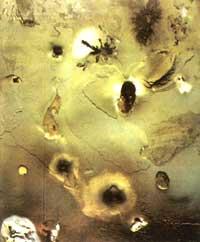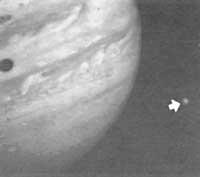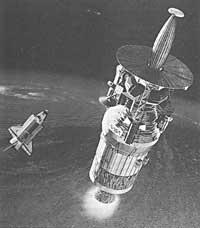Io, the hyperactive satellite of Jupiter
1989/01/01 Arregi Bengoa, Jesus Iturria: Elhuyar aldizkaria
Three other small satellites move within its orbit. As for its size, it is very similar to the Moon, its diameter is 3,640 km and its densities are practically equal: 3.5 g/cm 3 approx. Contrary to what these data could express, the similarity between Io and our satellite is limited to these superficial data.
Seen with telescope it looks like a mosaic of great color, with red, orange, yellow and intense white colors that characterize the broader aspects. The first supervised shows another obvious difference to the surface of the Moon, against what might be thought. No crater produced by the impact of meteorites has been found on the surface of Io. This observation is even more surprising considering that the influence of Jupiter's violent gravity field favors its abundance. Therefore, we must think of a process that eliminates the stains left by meteorites, that is, that reshapes the surface.
The answer is given by volcanoes that look like a black dot. These residues generate enormous volcanic activity (precipitation and reintroduction in the geological cycle) and contribute to surface renewal. In particular, it would be necessary to make a layer of tens of centimeters thick every thousand years to eliminate the craters that would occur depending on the estimated frequency of meteorite impacts. But what can be the source of energy that can generate violent activity in this body of size and density like the Moon?

If Io were the only satellite moving under the influence of Jupiter, it would have been the evolution of the Moon, and like this, the energy of the rotation movement would be lost through friction caused by the tidal effect caused by the planet. Therefore, the speed of rotation would always drop the planet with the same face until it moves, as in the case of our satellite. In this situation the attraction of Jupiter would cause a permanent abombation, giving Io a form of ellipsoid. But Io is not only influenced by Jupiter, but by his entire satellite system and, above all, by the other three Galilean satellites. As a result, Io's orientation towards Jupiter suffers significant oscillations and is responsible for volcanic activity for the enormous internal warming generated by the tidal effect.
In addition, another remarkable detail must be mentioned. Autochthonous is a special chemical based on the campfire. Without a doubt, volcanoes have expelled the gases and light compounds trapped inside, but the gravity zone of Io (as in the case of the Moon) is not as powerful as to keep these gases in the form of atmosphere around it. Therefore, the absence of water, oxygenated carbon compounds, etc. explains the domain of chemistry we have referred to.
As for the composition of the surface, the mixture that best suits the spectrum is as follows: 50% polysulfur oxides, x, 25% basalt, 15% S 2 O and 10% OS 2 . Disulfide oxide (S 2 O) and polysulfide oxides would form as a result of photodissociation of OS 2. Because the surface temperature is very low (about -150ºC), these compounds are frozen. In this situation OS 2 is white and polysulfur oxides, for example, would have a yellowish color.
In the internal structure of Io you can distinguish three layers: the core (solid and high density, about a third of its diameter), we would have a fluidizing mantle of silicates above, which would be the shell rich in sulfur silicates.
However, internal processes are not yet known too much. It seems to doubt two types of volcanoes: Type A and B. The seconds, much more violent than the first, can throw the matter at 1000 m/s. Most of the ejected ones fall back to the satellite, but a small percentage remains in the ionosphere.
Some also leave the ionosphere trapped by the magnetic field of Jupiter and form a plasma bull around the planet, deviated 7º from the plane of the satellite. Here you can find ions S +, O +, S 2+, S 3+ and O 2+, for example.
These are not all the remarkable singularities of Io, but they are clear exponents of his enormous activity.

Gai honi buruzko eduki gehiago
Elhuyarrek garatutako teknologia





